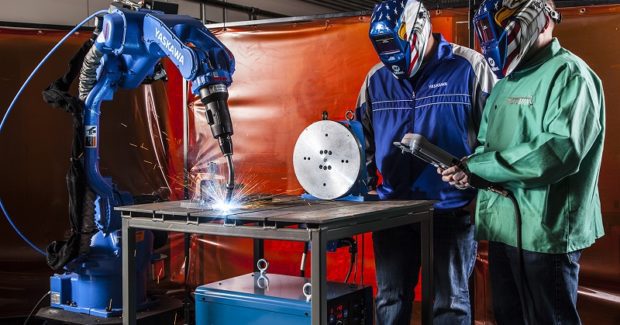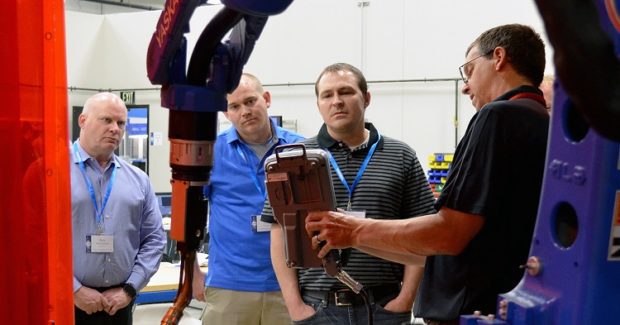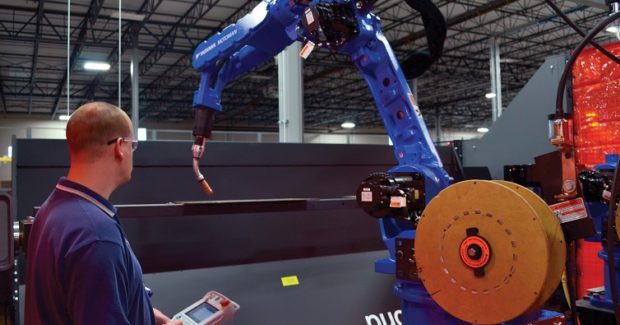Building a Robotic Workcell Champion
How do the most productive and efficient shops achieve faster ROI and rationalize more cell purchases? Many have a trained champion who garners support from other team members to meet deadlines and becomes accountable for the new or existing robotic workcell.
Posted: September 20, 2018
A major part of my work is going into customer facilities to see how robot utilization is being implemented and to learn how it aligns with current production processes. This face-to-face engagement provides a valuable opportunity to discover client pain points or system modifications impacting operations. In turn, this feedback provides insight into how we can develop better products, processes and services. I am usually joined by one of our robotics or welding experts who can give immediate advice on effective robot usage to instantly maximize uptime and accelerate ROI. One method that the most productive and efficient companies have found profitable (in more ways than one) is to build a robotic workcell champion.
WHAT IS A ROBOTIC WORKCELL CHAMPION?
In basic project management, every successful project will have someone who is a “champion” on the team and is accountable for many of the deliverables. This valuable team member garners support from other members to meet deadlines, and he or she becomes accountable for the new or existing robotic workcell. Whether the company is a job shop with one robot or a large manufacturer with three hundred robots, the workcell champion’s role is to ensure the full utilization and success of the robotic cell or cells. Likewise, the person selected for this position should be responsible for the productive use of the unit, managing the needed implementation, maintenance, programming and operator training. While finding the proper employee to meet these criteria may be challenging, offering incentives and rewarding the proper person for goals reached is advised when acquiring and retaining the needed worker talent.
WHO IS A ROBOTIC WORKCELL CHAMPION?
A workcell champion is typically someone who has plenty of personal drive and technical talent. Most of my customers are job shops that are welding parts, and it is not uncommon for decision makers to redeploy a skilled welder into this key position. Sometimes a shop will choose to hire a similarly qualified individual from the outside. Either way, this person is someone the company should invest in, creating a clear and optimistic path for future success. Effective communication is a must have, because tasks such as maintenance will need to be delegated. However, if there is no one else “to turn the baton over to,” the workcell champion must be willing to learn and accept new challenges.
HOW DO I TRAIN A ROBOTIC WORKCELL CHAMPION?
Training (or lack thereof) will make or break a workcell champion. It is imperative for the person in this position to know about the product components being made. Whether their necessary know-how comes through time and experience or by dedicated training, it is important for this person to know the specs and functions of the parts being manufactured. Company managers should never assume the employee being redeployed or hired knows all of the pertinent information needed to reach company objectives. A period of focused training, combined with real life application, will not only pay dividends for the life cycle of the robotic workcell being used, but also, the productivity of overall operations should improve and result in better product quality and operational efficiency. Decision makers would be wise to take an active role in helping a workcell champion reach his or her full potential.
For this person to be successful, they must understand how to program, use and maintain the robots and workcells being operated on the production floor. Accredited IACET providers and world-class robotics training facilities (like Yaskawa Academy) offer hands-on learning through a comprehensive training curriculum that provides robot operators, project managers, workcell champions and others with the chance to learn from the most experienced technicians and ask questions about current company processes along the way. Other training programs with a focus on lean manufacturing, Six Sigma, Kaizen, 5S and project management have been advantageous to workcell champions as well.
WHAT DOES THE WORKCELL CHAMPION DO?
Whether this person supports your first robotic workcell or your tenth, their main goal is to implement an efficient process that reduces cycle time and creates high quality products. This will involve finding parts to automate while likely providing feedback about the tool design, robot capabilities and operator training. Likewise, cycle times should be measured and steps to reduce them should be taken to achieve greater part output. At the same time, managing the flow of components will be an integral part of the job. Some shops find that offering incentives for reaching metric goals to key position workers is an effective tool for motivating employees. From the supplier to the workcell, the person in this position may also play an integral part in managing the flow of parts. Along with this responsibility, they should have the ability and authority to modify the cell, adding helpful tools, lights, fans and signs where applicable. In turn, they must be able to share this knowledge with cell operators as needed – in effect, equipping the company’s next workcell champion.
WHAT’S IN IT FOR YOUR COMPANY?
A capable robot is one that is designed to be used at whatever duty cycle an operator can throw at it. If a shop runs three shifts, so should the robot. But too often, I witness an underutilized robot. Not long ago, I spoke to two different customers on the same day. Each bought a cell that was designated to one part, and both shops were able to reach production goals in less time than planned. However, one allowed the robot to sit idle while the other had a workcell champion that programmed more jobs for the robot. The shop with the trained champion is seeing faster ROI and will, most likely, be able to rationalize another cell purchase in the near future.
In my experience, the main complaint that comes up in conversation with manufacturers is that retaining reliable and talented workers is more challenging and complex than they anticipated. When companies invest in employees to achieve new initiatives and goals, workers will most likely be more engaged. This has been the case with Millennials, the up and coming workforce.1 Shops that strive to work smarter by being proactive and providing a clear vision for the future will find employees to be more willing to invest time and talent toward the bottom line.
References
- Millennials + Work, Department 26 Strategic Intelligence, 2018



















